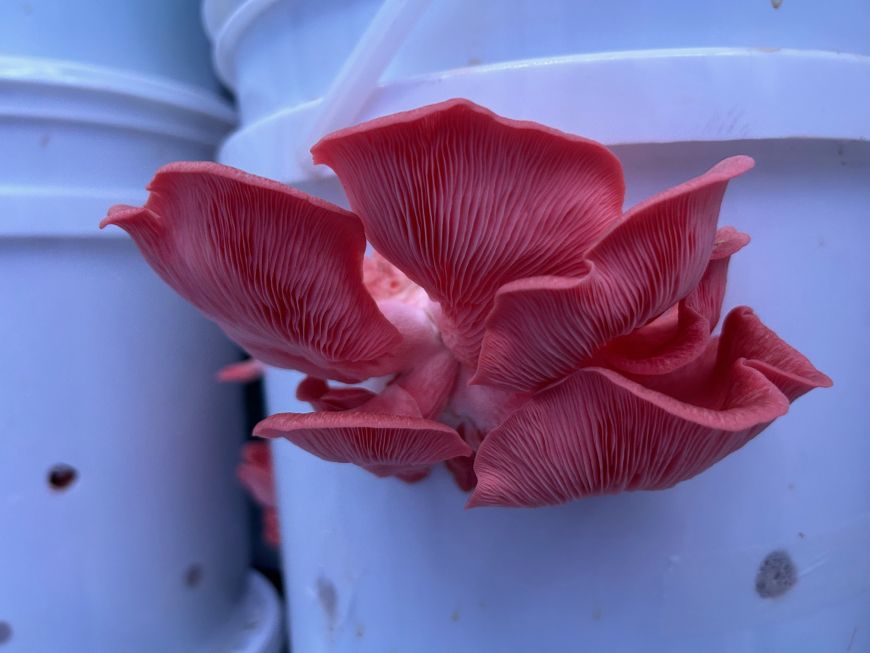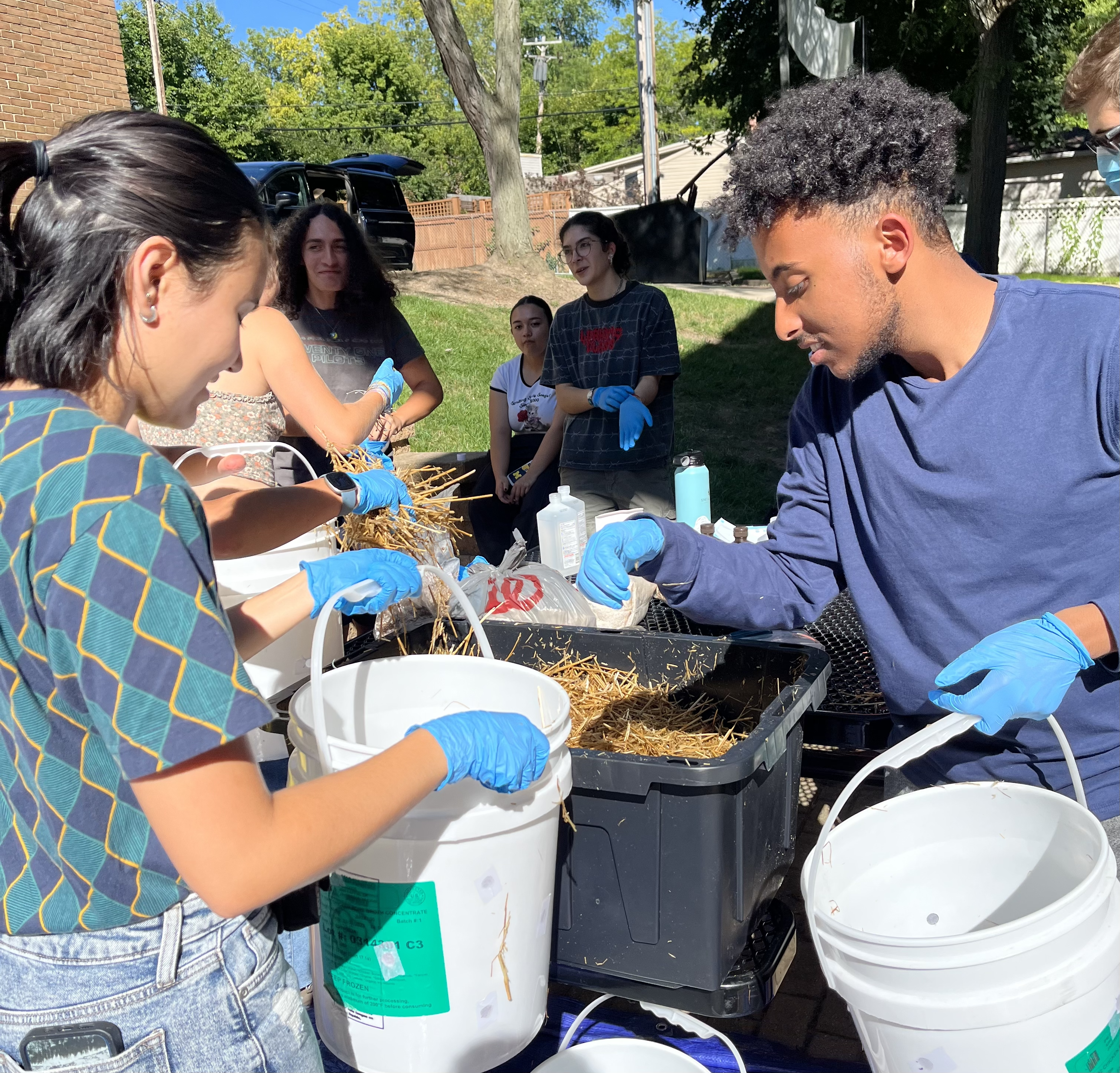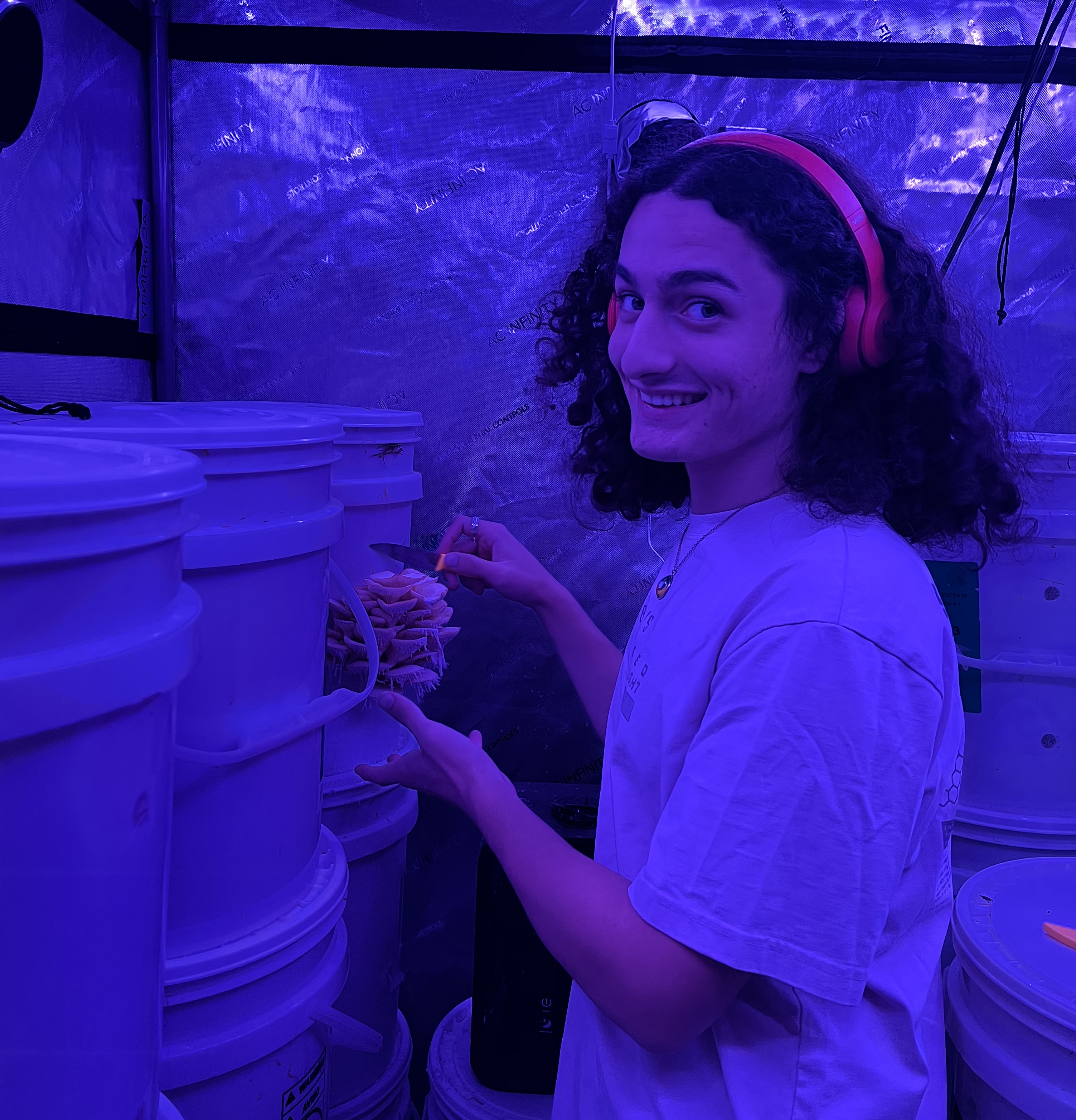
 back to all news
back to all news
U-M students are growing mushrooms, one of the most sustainable food options on the planet

Mushrooms come with a seemingly endless list of things that make them unique, including some that glow in the dark, some that are poisonous, and others that have been living for thousands of years. In the natural world, they are known as efficient decomposers and fast growers that play an integral role in maintaining and restoring the ecosystem.
Mushrooms are also a healthy food source packed with vitamins and minerals, including vitamin D, and are high in protein. Add to the list that mushrooms leave a small carbon footprint when grown and harvested, and they rise to the top as one of the most sustainably grown protein-rich food options on the planet.
As the director of the Sustainable Living Experience (SLE) at the University of Michigan, sustainability and, in particular, projects that promote sustainability, are at the top of Joe Trumpey’s mind. There was, for example, the time he worked with students to build a straw-bale building at The Campus Farm. So when he got interested in mushrooms and their many benefits, he had an idea: What if he and his students grew mushrooms?
“I got excited about mushrooms, especially knowing that the carbon footprint of growing and cultivating them is so low,” says Trumpey, who is an associate professor at the Stamps School of Art and Design and of natural resources at the School for Environment and Sustainability (SEAS) and the Program in the Environment, a jointly managed program between the College of Literature, Science and the Arts and SEAS. “I thought, what if we can grow them in a way that might eventually contribute to U-M’s goals for achieving carbon neutrality on campus?”
A chance meeting with Erin Hamilton of The Mushroom Conservatory helped turn his idea into reality. With Hamilton’s help and mentorship, they made plans to grow mushrooms and moved the equipment they would need into the basement of the Oxford Houses, where the SLE students live.
Hamilton, who left a career in advertising to pursue her passion for mushrooms about ten years ago, and whose business selling mushroom kits has expanded to 275 stores nationwide in a few short years, created a system for filtering spores that would work in a basement with no external ventilation.
“Joe and I spent time getting everything ready for the students, but they were the ones who set things up,” says Hamilton. “We had a day for building buckets. They drilled and sterilized them, then prepared the straw—they learned the whole process and did an amazing job.”

In September 2023, the students set up 60 five-gallon buckets, checked on them daily, and waited to see what would come. According to Hamilton, one of the many benefits of growing mushrooms is the rapidness with which you go from spore to harvest. “We set them up to grow golden and pink oyster mushrooms, as well as lion’s mane mushrooms. And then just four weeks later, they cultivated, tasted and shared them with the dining hall at U-M,” says Hamilton.
Trumpey had already connected with Michigan Dining’s Campus Executive Chef Frank Turchan about the possibility of supplying the dining halls with their mushrooms, so his team was prepared to use them in their cooking. Turchan says that partnering with students on food-related projects, in addition to sourcing as locally and sustainably as possible, is a priority for him and his team.
“Joe is always doing something interesting, and we will bounce ideas off each other,” says Turchan. “So when Joe asked me if I’d be interested in a mushroom project that involved students, I wanted to support him however possible.”
The students grew about 50 pounds of mushrooms during the fall semester, and they were served at Twigs, the dining hall at Oxford Houses. “The mushrooms were cooked into different dishes, such as pasta, and the students had the chance to work with one of the chefs at Twigs to learn about different mushroom cooking techniques and recipes,” says Turchan.
This semester, after the trials and tests of the first round, the students expect to grow a larger crop of mushrooms with the same 60 five-gallon buckets. They hope to yield about 12 pounds of mushrooms per bucket, which would mean they could be cultivating 720 pounds of mushrooms in the coming weeks. With 26,000 meals served daily in U-M’s dining halls, that may not be enough to feed all the students on campus, but Turchan estimates that it could provide meals for one day in two or three of the dining halls.
Hamilton says that this experience is giving the SLE students an understanding of not just sustainably grown foods, but of how food accessibility can be increased through mycology. “My goal is to take this program and replicate it across universities around the country so we can get more students diving into mushrooms and their many benefits,” says Hamilton.
The SLE students agree that this has been an important learning experience. “It isn’t necessarily connected to my career, but I love mushrooms and I’m having a dynamic and holistic experience that’s unique and exciting,” says James Ulery, an undergraduate student studying political science. “I’m interested in sustainability and knowing how to grow my own food, which is part of the reason why I joined SLE—to satisfy that side of me that goes beyond academics.”
Kaya McPhee, an undergraduate student studying computer science, shared a similar sentiment. “In our SLE class, we talk a lot about striving for carbon neutrality, and mushrooms are a sustainable source of food that we can grow in the basement. I’m learning a lot about sustainability in general, and I want to be focused on environmental issues that I can take with me to my career in coding or software.”

For Hamilton, the idea of using mushrooms in various fields and industries is not just realistic, but necessary. “There is so much to explore,” says Hamilton. “Scientists believe that the 14,000 or so species of mushrooms that have been discovered represent just one percent of the species in existence. That means that there are between 3-4 million species that are yet to be discovered, and I truly believe that the answers to restoring the ecosystem and ending world hunger are hidden in the fungi kingdom. They are so much more than a protein with no methane boost. They can clean up oil spills and potentially PFAS and mycelium [the root-like structure of a fungus] can even replace plastic in the textile industry and be used for 3D printing.”
Trumpey says that he’s excited to see where this project has gone, and where it can go as part of his curriculum for the SLE. “I plan to continue the mushroom project because it aligns so well with how I run the SLE seminar with a focus on sustainable foods,” says Trumpey. He adds, “Growing mushrooms provides students with the opportunity to engage in a very creative, hands-on project that directly serves U-M’s carbon neutrality goals and helps them consider innovative ways that they can deliciously contribute to sustainability.”

